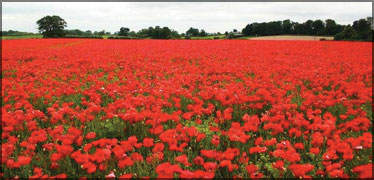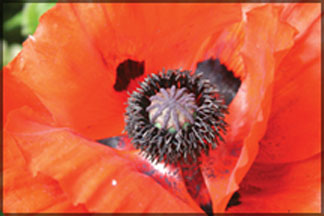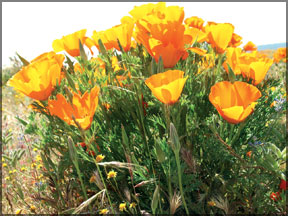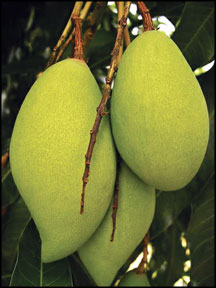|
Pet and Flowers |
Compiled by Damayanthi Hewamanna |
Poppy and its meanings
|

A poppy bud opening |
A poppy is a flower, typically with one per stem, belonging to the
poppy family. They include a number of attractive wildflower species
with colorful flowers found growing singularly or in large groups.
Those that are grown in gardens include large plants used in a mixed
herbaceous border and small plants that are grown in rock or alpine
gardens. The flower colours of poppy species include white, pink,
yellow, orange, red, and blue where some have dark center markings.
|

A field of poppies |
The species that have been cultivated for many years also include
many other colors ranging from dark solid colors to soft pastel shades.
The center of the flower has a whorl of stamens surrounded by a cup or
bowl-shaped collection of four to six petals. Prior to blooming, the
petals are crumpled in bud, and as the blooming finishes, the petals
often lie flat before falling away.
Symbols
Poppies have long been used as a symbol of both sleep and death.
Sleep because of the opium extracted from them, and death because of
their (commonly) blood-red color. In Greco-Roman myths, poppies were
used as offerings to the dead. Poppies are used as emblems on tombstones
to symbolize eternal sleep.
This aspect was used, fictionally, in The Wonderful Wizard of Oz to
create magical poppy fields, dangerous because they caused those who
passed through them to sleep forever.
|

The red poppy we wear on Poppy Day |
A second meaning for the depiction and use of poppies in Greco-Roman
myths is the symbolism of the bright scarlet colour as signifying the
promise of resurrection after death.
The poppy of wartime remembrance is Papaver rhoeas, the red flowered
Corn poppy. This poppy is a common weed in Europe and is found in many
locations, including Flanders Fields. Canadian surgeon and soldier, John
McCrae wrote the poem In Flanders Fields on May 3, 1915, after
witnessing the death of his friend, Lt. Alexis Helmer.
|

An orange poppy |
The opening line of the poem vividly describes the image of the
poppies blowing in the wind amongst the many crosses that mark the
resting places of fallen soldiers. Thus the plant became a symbol for
the dead World War I soldiers.
In many Commonwealth countries, artificial, paper or plastic versions
of this poppy are worn to commemorate the sacrifice of veterans and
civilians in World War I and other wars, during the weeks preceding
Remembrance Day on November 11. In the United States, it is common
practice to wear "Buddy Poppies" during the weeks preceding Memorial
Day, the last Monday in May to commemorate the sacrifice of veterans in
the various wars, whereas Veterans Day on November 11 is used to honor
"living" veterans. The design of the Canadian poppy consists of petals
made of red plastic with a felt lining and black centre held on by a
pin. In 1980, the Royal Canadian Legion formed a committee to decide the
future of the poppy and it was decided that the centre should be changed
to green to represent the green fields of France. This proved unpopular
with the Legion membership and the design was changed back in 1986.
Unfortunately a large quantity of green felt had already been purchased
and it was decided to keep producing the green centres until the supply
of felt was exhausted. It took until 2002 for the green felt to run out
and the traditional black centres reappeared. Those who were unaware or
had forgotten that black centres had been used in the design of the
poppy from its introduction in 1921 until 1980 found the change somewhat
controversial. The California poppy, Eschscholzia californica, is the
state flower of California.
Flavor
|

The California poppy, Eschscholzia californica |
The white poppy seeds form part of the Indian spices. They are added
for thickness, texture and also give added flavour to the recipe.
Commonly used in the preparation of Kurma, ground poppy seed, along with
coconut and other spices, are combined as the masala to be added at the
end of the cooking step. It is quite hard to grind them when raw, so it
is best to dry fry them, and then mix with little water to get the right
paste consistency.
|

Papaver rhoeas |
Poppy seeds are widely used in Turkish, Andhra, Bengali, Oriya,
German, Slovak, Czech, Ukrainian, Malabar (Northern Kerala), Romanian,
Hungarian cuisine and the Cuisine of Austria.
Although the drug opium is produced by "milking" latex from the
unripe fruits ("seed pods") rather than from the seeds, all parts of the
plant can contain or carry the opium alkaloids, especially morphine and
codeine. This means that eating foods (e.g., muffins) that contain poppy
seeds can result in a false positive for opiates in a drug test. The
test is true positive in that it indicates the presence of the drug
correctly; it is false only in the sense that the drug was not taken in
the typical manner of abuse.
The sale of poppy seeds from Papaver somniferum is banned in
Singapore due to the morphine content. Poppy seeds are also banned in
Saudi Arabia due to various religious and drug control reasons.
Source:Wikipedia
Adopt a Stray
Scores of bundles of canine joy will seek new homes and loving
families on Sunday, May 31 at the first 'Take Me Home' Adoption Day
organized by 'Embark', the personal CSR initiative of ODEL founder and
CEO Otara Gunewardene.

Dog lovers interested in taking home healthy, vaccinated, warmed and
groomed homeless puppies have been invited to visit a demarcated area
near the entrance at ODEL's Alexandra Place store on that day, to make
their pick.
The puppies have been rescued off the streets and cared for by the
Lucy Trust and the Laika Therapy Centre, and their re-homing will be
facilitated by Embark, which will register the new owners and offer
advice and follow-up assistance to ensure happy and successful
adoptions.
"This is the first phase of our new Adopt-a-Stray campaign to resolve
the problem of stray dogs in Sri Lanka," explained Ms Gunewardene, the
World Animal Day Ambassador for Sri Lanka. "We hope to organize one
Adoption Day event every month, to bring dog lovers and homeless stray
dogs together. Well-looked after strays make loving and loyal pets, so
it's a win-win proposition."
Two special marquees and a dog pen will be set up for the Adoption
Day on May 31 and puppies aged 3 to 12 months will be given away on a
first-come, first-served basis between 3.00 p.m. and 6 p.m.
Volunteers from Embark will make periodic visits to home that adopt
dogs to offer advice and help where needed. Sterilisation surgery, if
requested by the new owners of the adopted dogs, will be provided free
of charge by Embark.
Embark began in March 2007 with the aim of reducing cruelty to
animals and focusing on animal well-being and initiated a range of
activities to achieve these goals, from sterilization surgeries and
puppy re-homing campaigns, caring for injured stray animals and
educating the public about the importance of animal welfare. Since its
inception, Embark has helped change the mentality and thinking patterns
of community, encouraging love of community animals and has to date
sterilized nearly 2000 strays in seven campaigns.
Underneath the Mango tree
Mangoes belong to the genus Mangifera, consisting of numerous species
of tropical fruiting trees in the flowering plant family Anacardiaceae.

Cultivated in many tropical regions and distributed widely in the
world, mango is one of the most extensively exploited fruits for food,
juice, flavour, fragrance and colour. It is also the national fruit of
India and the Philippines. The Mango' comes from Portuguese manga, which
is probably from Malayalam manga.
Mango trees reach 35-40 m in height, with a radius of 10 m. The tree
is long-lived with some specimens known to be over 300 years old and
still fruiting.
The ripe fruit is variable in size and colours like yellow, orange,
red or green when ripe. When ripe, the unpeeled fruit gives off a
distinctive resinous sweet smell. In its center is a single flat oblong
seed that can be fibrous or hairy on the surface, depending on the
cultivar. Inside the seed coat 1-2 mm thick is a thin lining covering a
single embryo, 4-7 cm long, 3-4 cm wide, and 1 cm thick.
Mangoes have been cultivated in the Indian subcontinent for thousands
of years and reached East Asia between the fifth and fourth century BC
and by the 10th century AD, they were transported to East Africa and
subsequently introduced to Brazil, West Indies and Mexico, where climate
allows its appropriate growth. The 14 century Muslim traveller, Ibn
Battuta, reported it at Mogadishu. Mango is now cultivated as a fruit
tree in frost-free tropical and warmer subtropical climates like that of
the Indian subcontinent; nearly half of the world's mangoes are
cultivated in India alone.
Other regions where mango is cultivated include North, South and
Central America, the Caribbean, south, west and central Africa,
Australia, China, Pakistan and Southeast Asia.
Food
A ripe mango is sweet, with a unique taste that nevertheless varies
from variety to variety.
The texture of the flesh varies between cultivars, some having a
soft, pulpy texture similar to an over-ripe plum, while others have
firmer flesh like a cantaloupe or avocado.
In some cultivars, the flesh has a fibrous texture. In western
recipes of 'Chutney', ripe mangoes are often used, but chutney in the
Indian subcontinent is usually made with sour, unripe mangoes and hot
chillies or limes such as the famous Andhra mango avakai pachadi from
the south Indian state of Andhra Pradesh where almost every family of
Andhra Pradesh prepare mango pickles during the red hot summer season.
In India, ripe mangoes are often cut into thin layers, desiccated,
folded, and then cut. In many parts of India, people eat squeezed mango
juice (called ras) on a variety of bread. This is part of the meal
rather than a dessert.
Unripe mangoes (which are extremely sour) are eaten with salt, and in
regions where food is hotter, with salt and chili. In Kerala, ripe
mangoes are used in a dish called mambazha kaalan.
During the hot summer months, a cooling summer drink called panha (in
Marathi) and panna (across north India) is made with raw mango. Mango
lassi is made by adding mango pulp to the North Indian yoghurt drink
lassi. The fruit is also used in a variety of cereal products, in
particular muesli and oat granola. Wikipedia
Chester Williams Muthuveloe
Chester was only a dog but he had the skill of making people feel
SPECIAL. Maybe that was his gift to us, the Muthuveloe family. As he
battled with increase in age, stiffness of his hip joints and
unpredictable sphincter functions, putting him down seemed to be the
most correct thing to do. But the end was the most difficult for us, his
family, and waiting for the vet was the longest and saddest time for the
four of us.
|

Chester |
I never thought that any situation like this could cause me such
distress. As a forensic psychiatrist, I have dealt with death, including
suicides in my career, which has never had this great effect on me.
Chesters death was entirely different to all the others. I will never
know why this was to be so.
Fifteen years ago I put up the strongest possible case not to have a
dog but was outnumbered 3 to 1. I had allowed my daughters to have a
hamster and a rabbit but was definitely going to draw the line at a dog
which was going to cost us over 300 pounds! I lost the argument and the
battle. But had I won, it would have prevented me from ever getting to
know the character who was to be Chester.
Chester was the runt of a litter of 6 golden and 3 black Labrador
pups and entered our home at the age of 5 weeks as a ball of black wool
hardly bigger than my foot! South Africa had won the World Rugby cup in
the summer of 1995 so we named him after the black South African rugby
player, Chester Williams. Chester, though built like a rugby player and
at times behaving like one by hurling himself at you for a tackle, was
not capable of winning anything other than HEARTS!
Our life together started off as a form of boisterous and chaotic
so-habitation, which had to be lived mainly by his rules. He proceeded
to destroy my house and garden in grand style! We had a reasonably
well-landscaped garden with a fishpond, a fountain, a lily pad and
carpeted floors in the house - none of which remains today! Chester
jumped in and out of the pond, killed the fish, ate the lily pad and
then chewed the wires of the fountain.
He then ran amok around the house turning my clean pale carpets into
a darker shade of brown. He then broke the fence of our home and ate all
the flowers in our neighbours gardens. There was no knowing which irate
neighbour we would have to placate on our return from work or school. I
was convinced that we would lose favour with our neighbours and alienate
friends but strangely the opposite happened.
Chester introduced us to so many people that even the stiff
upper-lipped kind became friendly with us in no time. He was known
throughout Great Linford as 'Chester, the doctor's dog'. Children who
consulted my husband Sam spent time talking about seeing Chester on his
walks. He made us walk miles and I am sure I have clocked up walking to
Sri Lanka and back if I was to add up the hours of walking that I have
done with him in sunshine, rain, hale and snow!!
We laid Chester to rest in our garden. The spot we chose to be his
final resting place was the site of our pond, which no longer exists.
Neither is there fish, a lily pad or a fountain. Maybe he knew all along
that special place belonged to him.
Ayesha Muthuveloe
A home for Suki and Suzy
Suki and Suzy have been wormed and innoculated against Rabies, Parvo
and DHL. They are healthy and affectionate and will make loyal and
loving pets. So if you are interested and want to give these two
loveable dogs a happy home to live in please call 0777-221444. STRICTLY
FOR ANIMAL LOVERS.
|



